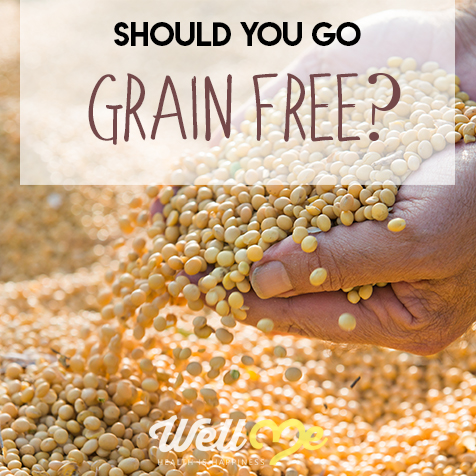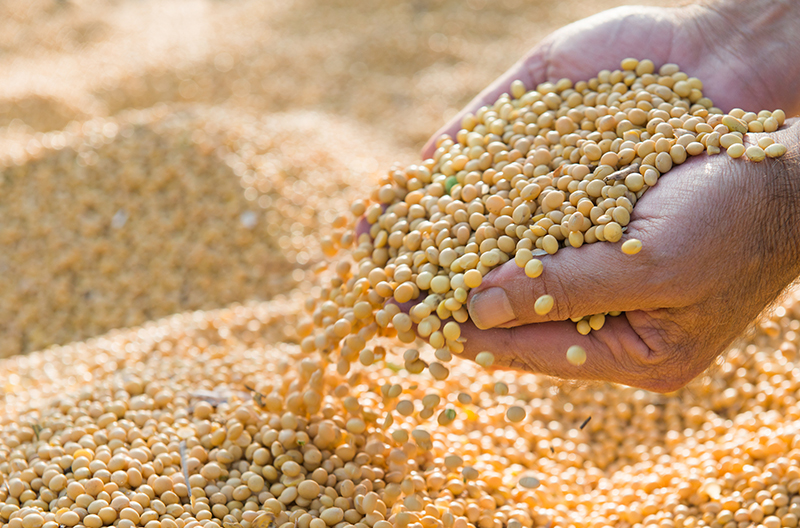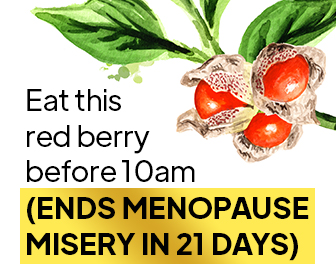What did you eat for breakfast this morning? Did it include bread or cereal?
What about lunch? Did you have a sandwich, or maybe a bowl of pasta?
If you take just a minute to think about it, you may come to the realization that grains are a major part of your diet. If they are, know that you aren’t alone! In fact, most of the Western world is with you. But maybe that’s part of the problem.
Because grain-based foods are so common, it’s easy to fall back on these foods. You probably already know that they aren’t always the healthiest choice, but do you have what it takes to go grain free? With the rising popularity of the gluten free trend and the scientifically proven benefits of the Paleo diet, more and more people are switching to a grain free diet.
If you’ve been thinking about going grain free, you may already know just how big a decision it is. You probably also know how difficult it can be to stick to this kind of diet. So, if you’re wondering if you have what it takes, or if you’re still on the fence, ask yourself the following ten questions to determine whether the grain free diet is really the best choice for you.
Question 1: Why Am I Doing This?
Before you make any major decision in life, it is important to question your motives.
Eliminating grains from your diet is no small change, and it isn’t going to be easy. So, if you’re doing it for the wrong reasons you may give up early on because it’s too confusing or too much of an inconvenience. If you’re truly doing it for health-related reasons, that will be part of your motivation to keep going.
But why exactly would someone make the decision to go grain free? Here are some of the top reasons people cite for cutting grains out of their diet:
- Problems with food addiction, particularly for carbohydrates, and it is causing them to gain weight or threatening their health.
- An allergy, sensitivity, or intolerance for one or more grains (or they have Celiac disease or gluten intolerance).
- Digestive problems like IBS or leaky gut and suspect that grains may be part of the problem.
- Following a Ketogenic Diet (a low-carb, high-fat diet) and have decided to make things easier by eliminating grains entirely.
- Doing a test run of the Paleo Diet a try to see if they can give up grains before making the full commitment.
Your own reasons for switching to a grain free diet may be a combination of one or more of these reasons, or it might be none of them at all. Whatever your reasons may be, know what they are before you start!
Question 2: Am I Going to Involve My Family?
Switching to the grain free diet is a decision you need to make for yourself. If you have a family – especially if you do most of the cooking for your family – think about whether it is a decision you’ll also be making for your family. Ask yourself whether it’s really in their best interest.
When making major changes to your diet, having your family on board can be very helpful. You have to ask yourself, however, whether the change will benefit your family as much it benefits you. Be honest with yourself about whether it’s going to be more work to have your family to make the switch with you. If you have young children, the switch may not only be impractical, but it may leave a nutritional gap in their diet.
Fun Fact: According to the Academy of Nutrition and Dietetics, carbohydrates are an important piece of the nutritional puzzle for growing children. Carbohydrates are the preferred fuel source for growing muscles and developing brains, plus they are a diverse nutrient group rich in a variety of vitamins and minerals. Cutting grains out of a child’s diet could leave some large nutritional gaps, particularly when it comes to fiber. Children between the ages of 1 and 8 need as much as 24 grams of fiber per day and it can be tough to reach that goal without grains.
Question 3: How Far Am I Willing to Go?
Before you commit to a grain free diet, you need to ask yourself how far you are willing to take it.
Giving up your morning muffin or kicking your pasta habit is one thing. Checking food labels on your favorite sauces and condiments is another. Did you know that most soy sauce contains wheat? Or that malted milk powder is made from ground barley?
That’s right – your favorite milkshake might not be as grain free as you thought!
Before you can decide how far you want to take your grain free diet, you need to understand exactly which foods contain grains and which do not. You need to be able to make an informed decision or there is no way you’ll be able to stick to it.
Here is a quick list of grains to avoid as well as some surprising foods you may not have considered:
- Barley
- Bran
- Bulgur
- Corn
- Cornmeal
- Couscous
- Farina
- Graham flour
- Kamut
- Millet
- Oats
- Orzo
- Rice
- Rye
- Semolina
- Sorghum
- Spelt
- Teff
- Triticale
- Wheat
- Wild rice
- Bagels
- Beer
- Blue cheese
- Biscuits
- Bread
- Cakes
- Cereal
- Cookies
- Crackers
- Imitation crab
- Malt powder
- Muffins
- Pancakes
- Pasta
- Pita
- Pizza
- Pretzels
- Popcorn
- Soy sauce
- Spaghetti
- Tortillas
The list goes on and on. Take a quick look and ask yourself whether you’re really ready to give up all of those foods. If you think about it, you may realize that you aren’t ready to completely give up grains. As a compromise, you may want to go gluten free intead. Keep reading to learn more.
Question 4: Do I Know the Difference Between Grain Free and Gluten Free?
This question goes hand-in-hand with the previous one. In considering how far you are willing to go with your new grain free lifestyle, ask yourself whether you want to go completely grain free or whether going gluten free might be enough.
Do you even know the difference?
Gluten is a type of protein found in certain types of grains such as wheat, barley, and rye[1]. It is what helps grain-based foods like bread and pizza dough hold their shape while maintaining some level of elasticity. If you’ve ever made homemade bread, the kneading part of the process serves to break up the gluten in the flour so the bread will rise and have that spongy texture.
If you’re going to go follow a grain free diet, you need to realize that all foods that contain gluten contain grain but not all foods that contain grain contain gluten. Confused? If so, you pay special attention to the next question on this list.
Question 5: Do I Know How to Read a Food Label?
Okay, so let’s say that you bite the bullet and decide to give up grains.
How do you actually make it happen? Not only should you know which foods contain grains, but you need to be able to identify them. Yes, you’re going to have to start reading food labels.
When you look at a food label, there are a few key parts to pay attention to. First and foremost, check the allergen section. If it lists wheat or gluten, you can put the product right back on the shelf. Just because wheat or gluten aren’t listed in the allergen section, however, doesn’t mean that the product is grain free!
After checking the allergen warning, take a look at the ingredients list. The ingredients list on a food label is arranged in descending order by volume. This simply means that the ingredients used in the highest volume are at the beginning of the list. If you see any type of grain or grain-based flour on the ingredients list, put the product back on the shelf.
Sounds easy enough, right?
In some cases, it is. If wheat or gluten is listed in the allergen warning there’s no reason to go on and read the ingredients list. If you do have to read the ingredients list, however, you may find that it isn’t always easy to determine whether a product contains grain or not. It’s going to take some practice to learn how to read a food label and how to identify grains and grain-based ingredients.
Question 6: Am I Willing to Make Compromises?
This question may seem the same as Question #3, but it is still important to ask.
If at this point you’re really starting to question whether going switching to a grain free diet is a commitment you’re willing to make, you might consider whether there is some kind of in-between option. Even if you do decide to go completely grain free, you may find yourself making compromises somewhere along the way.
What might this look like?
Let’s say you decide that going completely gluten free isn’t practical for you but you do want to eliminate gluten from your diet. Are you going to eat instant oatmeal although it’s not officially certified gluten free, even if that only means that it could have been processed on shared equipment that also processed wheat?
There is no rulebook. It’s entirely up to you how strict you are with your decision to go gluten free or completely grain free. You should ask yourself, however, what you will do when faced with this kind of decision. Are you willing to make compromises or will you stand your ground, even if it means a lot more work for you?
Fun Fact: Making the decision to go grain free isn’t easy, and it won’t be easy on your body either! When you make a sudden change to your diet (especially if it means cutting out the foods you’ve been eating so much of), your body may go through a period of withdrawal. You might experience headaches, fatigue, leg cramps, and even anxiety or depression. Know that this could be a possibility before you make the commitment!
Question 7: What Will I Do When I Eat Out?
In addition to asking yourself whether you’re willing to make compromises in your grain free diet, you should think about what you’re going to do if you eat out or have dinner at a friend’s house.
In situations like these, you may not always be in control of your food options. If you’re lucky, you’ll find yourself in an allergen-friendly restaurant that uses “gluten free” or “grain free” labels on their menu. If not, you’re going to need to know how to identify grains in menu descriptions and you’ll need to have some idea how to modify the dish to make it grain-free.
In some cases, your task might be as simple as replacing a side of steamed rice or pasta with a salad or vegetable. You may even be able to order a burger without the bun. Keep in mind that gluten free buns, even when they are available, won’t necessarily be completely grain free!
When you’re having dinner at someone else’s house, you may not have these options. If you feel comfortable doing so, you may be able to tell that person about your dietary choices and they may or may not be willing to make accommodations. You could also offer to bring a grain free dish to share, thus ensuring that you have something to eat as well.
Question 8: How Will I Explain My Choice to Others?
This question goes hand-in-hand with the one before. If you’re going to be eating a meal out or at a friend’s house, you should be prepared to tell other people that you’ve decided to eliminate grains from your diet and why.
Again, your reasons for switching to a grain free diet are entirely your own. Even so, you should know what those reasons are and you should be able to articulate them to another person, if necessary. It can be difficult to do this, sometimes, especially when the other person doesn’t understand why you would make such a decision.
In moments like these it is important to remember your motivation and remind yourself that your choices are your own – you don’t need to explain yourself to someone else if you don’t want to.
Question 9: What Will I Do If I Make a Mistake?
Sticking to any diet can be a challenge, even if it isn’t so restrictive as a grain free diet.
No matter what diet you choose to follow, you will inevitably make mistakes from time to time. Maybe you’ll find yourself standing in front of the pantry after a particularly long day of work and all you want to do is throw a cup of instant noodles in the microwave. Or maybe you’ll be driving the kids home from school and they want to hit the drive-thru.
What are you going to do when you slip up and allow yourself to eat something made with grains?
You really have two options: you can berate yourself and label yourself a failure, or you can accept your mistake and move on. Many dietitians actually recommend an 80/20 approach to dieting. This simply means that you strive to follow the diet as much as you can but give yourself room for mistakes about 20% of the time.
It’s also possible, of course, that you’ll eat something that contains grains entirely by accident. In those moments, all you can really do is shrug it off. Just keep it in mind for next time, and move on.
Question 10: How Will I Motivate Myself to Keep Going?
Finally, if you do decide to go grain free, ask yourself how you’re going to stay motivated to stick to that decision once you’ve made it.
This is another time when you’re going to have to call upon your reasons for making the switch. In many cases, those reasons will be your motivation. Are you trying to lose weight? Improve your health? Relieve unpleasant digestive symptoms?
It is up to you to find your motivation and, once you’ve found it, keep reminding yourself of why it is that you are doing what you’re doing! It’s really that simple.
Summary: What Should You Do Now?
If you’ve really taken the time to ask yourself each of these questions – and if you’ve been honest with your answers – you already know what to do next.
Many people who switch to the grain free diet do so without actually putting much thought into it. When they realize just how grain-centric their diet actually is, many of these people balk. They may decide that they can’t live without their morning muffin or don’t want to deal with the hassle of gluten-free cooking.
What you really need to do now is evaluate your answers to the ten questions above. Think about whether a grain free diet is really the best choice and, if so, whether you can fully commit to it and for how long. If you’re still set on giving up grains, here are some simple steps to get started:
5 Tips for Switching to the Grain Free Diet
- Compile a list of grain-containing foods as well as a list of foods that are grain free. You can do your own research to come up with a list as detailed as you like, or you can just do an online search for a grain free food list (a Paleo diet food list will work).
- Take your list of grain-containing foods and go through your pantry and fridge. If your whole family is making the commitment, you can just get rid of those foods. If you’re going solo, gather all of those foods into one area so you know what to avoid.
- Bring your list of grain free foods with you and head to the grocery store to stock up on grain-free staples and snacks. You may even want to come up with a list of recipes you plan to follow for the next week or two so you know exactly what you need to buy.
- Start to slowly eliminate grains from your diet by replacing one grain-centric meal at a time with a grain free option – if you switch too quickly you might experience withdrawal symptoms or lose your resolve.
- Keep at it! Once you’ve completely eliminated grains from your diet, just stick with it. It may help to make a habit of trying new recipes so you don’t get bored and you should have plenty of grain-free snacks on hand for those times when you can’t prepare something yourself.

It would be inaccurate to say that grains are always bad just as much as it would be wrong to say that they are always good. The truth is that there are no black and whites when it comes to nutrition – you should do what works for your body and what you are able to consistently maintain. If switching to the grain free diet is the right choice for you right now, by all means do it! Best of luck!
References
- [1] “Sources of Gluten.” Celiac Disease Foundation. <https://celiac.org/live-gluten-free/glutenfreediet/sources-of-gluten/>
- Fun Fact Source: Larson, Holly. “Children Need Carbohydrates.” EatRight.org. <http://www.eatright.org/resource/food/nutrition/dietary-guidelines-and-myplate/children-need-carbohydrates>








